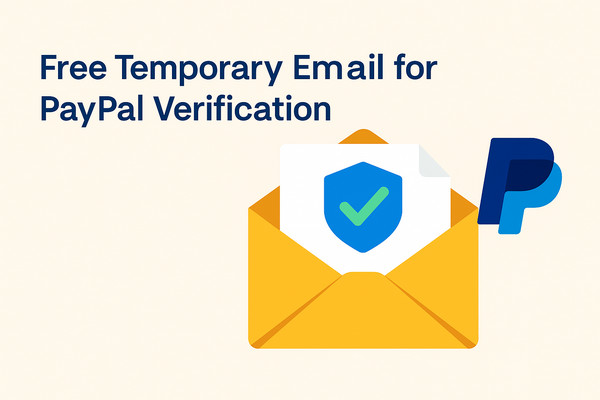This Free Temp Mail Tool Is Saving Users from Spam – Find Out How!

Comparing Top Free Temp Mail Tools in 2025
Temporary email tools have evolved significantly, and in 2025, users are spoiled for choice. From simplistic platforms to highly secure services, the landscape of temp mail providers is rich and varied. Let’s break down three of the most popular tools dominating the scene this year.
Temp-Mail.org
One of the most trusted and widely used platforms, Temp-Mail.org offers a straightforward user experience. The moment you visit the site, you’re provided with a random, disposable email address—no login, no signup. This email is active for a set period and can be refreshed or changed with a click.
Why users love it:
-
Clean, ad-free interface
-
Instant mailbox with inbox refresh
-
Supports receiving emails, including attachments
-
Available as a Chrome extension and Android app
It’s perfect for users who value simplicity and reliability. However, it may sometimes be blocked by websites with aggressive bot protection.
Guerrilla Mail
Guerrilla Mail is the OG of temporary emails. Known for its edgy branding and powerful backend, this service offers more control over your temp email experience.
Notable features:
-
Choose your own email prefix
-
Inbox persists as long as the browser session is active
-
Email scrambling for better anonymity
-
Open-source credibility
Advanced users appreciate the extra features, but casual users might find the interface slightly outdated compared to sleeker alternatives.
10 Minute Mail
As the name suggests, 10 Minute Mail provides a disposable email valid for 10 minutes. Perfect for quick signups or verification codes, it’s ideal for fast, no-fuss interactions.
Perks of using 10 Minute Mail:
-
Zero clicks needed—email is instantly active
-
Automatic countdown timer
-
Option to extend the session if needed
-
Extremely lightweight and fast loading
It’s great for speed but not ideal if you need a longer-term solution.
Advantages Over Traditional Email Providers
You might wonder, why not just use a secondary Gmail or Yahoo account? While that’s an option, temp mail offers unique benefits that standard providers can’t match.
No Long-Term Commitment
With traditional email, you’re committing to managing inboxes, updating passwords, and dealing with spam filters. Temp mail eliminates all of that. Need to download a whitepaper or sign up for a one-time webinar? Temp mail gets the job done without any strings attached.
Think of it as a burner phone—but for emails. No login, no user profile, no lingering data. Once you close the session or the expiration period hits, everything disappears.
Enhanced Online Privacy
Every time you enter your email on a site, you leave a digital breadcrumb. Over time, these crumbs form a complete picture of your online activity. Temp mail helps you avoid that.
Here’s how it protects your privacy:
-
Prevents linking of activities to your real identity
-
Blocks tracking pixels commonly embedded in email content
-
Avoids creating a data footprint that can be sold or leaked
For privacy-conscious users, this is a game-changer. Especially in an age where even “secure” platforms have suffered massive data breaches, using a temp mail is like wearing a cloak of invisibility online.
Limitations and Challenges of Temp Mail Services
While temp mail offers a host of benefits, it’s not without flaws. Understanding its limitations helps you use it wisely and avoid frustration.
Short-Lived Inbox Access
The most glaring downside is the temporary nature of the email itself. If you close your browser or wait too long to check for a verification code, your email might expire—and there’s no getting it back.
This can be problematic when:
-
Services delay sending confirmation emails
-
You forget to copy important info from the inbox
-
You need to recover an account later
Unlike Gmail, there’s no “Forgot Password” option here.
Compatibility Issues with Some Sites
Some websites have caught onto the temp mail trick and proactively block them. You might get error messages like “invalid email” or “domain not accepted.”
Also, certain services require email verification loops or ongoing communication (like newsletters or account notifications), which makes temp mail a poor fit. In such cases, a dedicated spam email might be a better alternative.
Tips to Maximize the Benefits of Temp Mail Tools
Temp mail is powerful, but only when used right. Here’s how to get the most out of it.
When to Use Temp Mail vs. Personal Mail
Use temp mail for:
-
Free trials or demo access
-
Downloading eBooks or reports
-
One-off registrations (forums, discount clubs)
-
Avoiding phishing attempts
Use personal email for:
-
Banking or financial services
-
Long-term subscriptions
-
Professional communication
-
Important notifications and backups
Knowing when to draw the line is crucial to maintaining both convenience and security.
Best Practices for Digital Hygiene
To make the most of temp mail, follow these best practices:
-
Always copy important data before the email expires.
-
Double-check email addresses before submitting.
-
Use VPNs or ad blockers in conjunction with temp mail for extra anonymity.
-
If you need more time, pick tools that offer inbox extension features.
-
Avoid using temp mail for sensitive or confidential information.
Temp mail is like disposable gloves—great for quick, dirty tasks, but not meant for surgical precision.
Temp Mail for Businesses and Professionals
You might assume temp mail is just for casual users or tech-savvy individuals who want to stay off the radar—but guess what? Businesses and professionals are tapping into these tools too. Why? Because they offer agility, anonymity, and efficient management of digital clutter.
Market Research and Beta Testing
Businesses often need to test competitors’ platforms, sign up for newsletters, or access gated content for research purposes. Using a personal or corporate email for this can clutter up your primary inbox—or worse, alert the competitor.
Here’s how temp mail is useful:
-
Anonymous access to competitors’ services for strategic analysis
-
Free signups for tools under multiple personas to test usability and onboarding
-
Receiving promotional content from various companies without blowing your real inbox
Imagine you’re doing beta testing and want real feedback from random emails—you can set up multiple test accounts using temp mail and avoid wasting time clearing them out later.
Avoiding Corporate Spam
Sign up once for a SaaS platform and you’re bombarded with automated emails—welcome sequences, product tips, upsells, feedback requests. It never ends.
Professionals can use temporary emails when:
-
Testing out new marketing platforms
-
Joining one-time webinars or product demos
-
Accessing free resources without ongoing correspondence
This not only protects your primary inbox but also ensures your productivity isn’t sabotaged by an endless wave of automated outreach.
The Future of Temporary Email Technology
As the digital world evolves, so does the need for smarter tools. Temporary email services are no exception. While current platforms do a solid job, the next wave of innovation is poised to make these tools even more robust, secure, and user-centric.
AI Integration and Smarter Spam Filters
Artificial Intelligence is already transforming how we deal with email. Temp mail tools are likely to adopt AI in these ways:
-
Smart filtering of malicious or phishing emails before they hit the temp inbox
-
AI-generated aliases based on your browsing patterns
-
Auto-detection of OTPs or verification codes with auto-forwarding options
These advancements can make temp mail services feel like smart assistants rather than just disposable tools.
More Secure and Customizable Options
Right now, most temp mail tools are limited to standard domains and basic inboxes. In the near future, we may see:
-
Custom domain support for branded disposable emails
-
Encrypted inboxes with temporary access keys
-
User-controlled expiration timers and manual deletions
-
Browser notifications for incoming temp mail
The goal is to give users more control without sacrificing the core purpose—temporary, anonymous communication.
How to Choose the Right Temp Mail Tool for You
With so many options available, how do you pick the one that fits your needs? It’s not about which one is best, but which one is right for you.
Factors to Consider
When choosing a temp mail service, ask yourself:
-
How long do I need the inbox to stay active?
-
Do I need to receive attachments?
-
Is a user-friendly interface important to me?
-
Do I need custom domains or aliases?
-
Will I be accessing it via mobile or browser only?
For quick, one-off uses, a basic tool like 10 Minute Mail does the job. But if you’re looking for more flexibility or frequent use, go for options like Temp-Mail.org or Guerrilla Mail.
User Reviews and Ratings
Before settling on a tool, check real user feedback. Look for:
-
Performance and speed
-
Customer support (if applicable)
-
Reports of bugs or outages
-
Site uptime and domain block rate
Forums like Reddit, Trustpilot, or specialized tech blogs often provide deep insights into what users love (or hate) about each service.
Frequently Asked Questions About Temp Mail
Are Temp Mail Services Legal?
Yes, they are completely legal to use. They’re just alternative ways to receive emails. That said, how you use them matters. Using temp mail for fraud, impersonation, or other malicious purposes is illegal and unethical.
Can I Receive Attachments?
Some services support it, while others don’t. For example, Temp-Mail.org allows attachments, but 10 Minute Mail typically doesn’t. Always check the feature list before relying on a temp mail tool for receiving files.
Is Temp Mail Traceable?
Most temp mail services don’t store your IP or activity logs—but nothing is 100% untraceable. Advanced tracking methods, like browser fingerprinting or server logs, can sometimes be used to triangulate a user’s identity. So, always pair it with tools like VPNs or browsers with privacy modes for better protection.
Can I Use Temp Mail on My Phone?
Absolutely. Many services now have mobile-friendly interfaces or even apps. Just be cautious about permissions and check whether the app is from a trusted source.
What Happens When My Email Expires?
The inbox and all its contents are permanently deleted. You can’t retrieve anything after expiration. So, make sure to copy or screenshot anything important before the session ends.
Final Thoughts
The internet is full of noise, and your inbox often becomes the front line. From endless promo emails to phishing scams and unwanted newsletters, managing your digital identity has never been more crucial. Free temp mail tools are the silent heroes of this battle, giving you the power to control your inbox, maintain privacy, and dodge spam like a pro.
Whether you’re a casual user signing up for a one-off offer, a professional shielding your primary inbox, or a researcher exploring your competitors’ strategies, temporary email services are versatile, efficient, and incredibly easy to use.
Don’t just let the web throw junk your way—start filtering it on your terms.
read more articles:-
- 6 Best Disposable Temporary Mail Services for 2025
- What is 10 Minute Mail: Disposable Temporary Email Service
- Best Temporary Email Generator Free #1 – The Ultimate Guide to Anonymous, Disposable Email Services
❓ FAQs Recap
-
What is the best free temp mail service in 2025?
Temp-Mail.org offers the best blend of usability, speed, and features. -
Can I use temp mail for multiple signups?
Yes, and some tools let you customize addresses for easier tracking. -
Is temp mail better than a spam-dedicated Gmail account?
For quick tasks—absolutely. No logins, no clutter, no tracking. -
Can websites block temp mail addresses?
Yes, some sites maintain blocklists. Try rotating tools or domains if needed. -
Are there risks to using temp mail?
Only if you use it for sensitive tasks. For everything else, it’s a safe bet.




